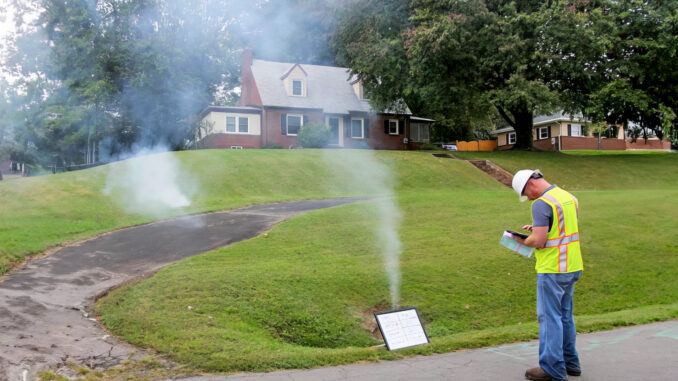
MONTVALE—The fire and police departments will be on standby over the next few weeks as the borough carries out smoke tests on the sanitary sewer lines, starting near the Valley View pump station, in search of illegal sewer connections.
Non-toxic smoke—akin to what one sees at concerts, said the borough—will be pumped through the sewer lines in 1,000-foot intervals. If an illegal sewer connection is present, smoke will be released from the line and the homeowner will see it coming from a sump pump, roof drain, or other similar connection.
Mayor Michael Ghassali wrote residents on Friday, Jan. 12 to describe the process and its rationale, and to say “We will have numerous emergency services personnel, Colliers employees, and other resources to track the smoke and work with the homeowner to mitigate the issue.”
Ghassali wrote, “More rain is on the way, and with the recent heavy rain storms, we have been noticing a sizable increase in stormwater showing up in the sanitary sewer lines, particularly in the west side of town.”
He said, “During normal operations, the current sewer system has more than adequate capacity for the sewer flow. Similarly, Montvale’s separate storm sewer system typically has more than enough capacity to convey groundwater from private property and public street culverts safely and efficiently.”
He said, “However, stormwater inflow from illegal hookups and groundwater infiltration from leaky pipe joints have created harsh demands on the system during major rain events. We have devoted substantial staff hours and capital resources to mitigate the situation.”
Such inflow and infiltration, he said, has caused backups in floor drains and basement plumbing fixtures when the volume of groundwater in the sanitary system exceeds its capacity.
“This is not only costly in terms of sewage treatment expenses, but it is overloading our pump stations at Valley View Terrace, Huff Terrace, and Middletown Road. The two systems should not be intermixed. Often, however, homeowners have illegal sewer connections that they may not even be aware of,” said the mayor.
He said illegal sewer connections include connections from sump pumps, floor drains, roof leaders and any other systems that convey stormwater, groundwater, roof runoff, subsurface drainage, foundation drainage or cooling water into the municipal wastewater system.
“Prior to any smoke testing, we will be notifying all potentially affected homeowners so we do not cause a town-wide panic. I strongly encourage you to check your roof leaders, sump pumps and other storm drains and ensure they are not connected to the sanitary sewer system,” said Ghassali.
If you do find any illegal connections, contact the Building Department for help working through the process to remedy the situation.
“Both the borough and your neighbors thank you for taking this matter seriously. No date has been set as of yet, but this is necessary and as mentioned, you will be notified when the test is ready,” the mayor said.
Ghassali also provided a FAQ on the issue:
Q. What is the reason for smoke testing?
A. Smoke testing is undertaken to find leaks before they become larger problems. It’s one of the several investigative methods used to locate inflow sources in a community’s sanitary sewer collection system.
Typically, direct sources of surface water or groundwater can enter a collection system during rainfall events, including catch basins, area drains, house roof downspouts, sump pump discharge and/or foundation drains directly connected to the sanitary system or storm sewer.
We will test sewers by putting non-toxic smoke into the sewers to find leaks and faulty connections. This method of field investigation is helpful in detecting direct connection points of groundwater or surface water intrusion into the sewer. The process is cost effective and highly efficient.
Q. What is smoke testing?
A. Smoke testing involves pushing a simulated, non-toxic smoke (similar to products used at concerts and theater venues during live performances) through a community’s sanitary sewer collecting system, then observing and documenting where the smoke exits. This method for identifying I&I typically involves residential, commercial and industrial areas.
Field technicians set up a blower over a neighborhood manhole, and non-toxic smoke is pumped through the sewer line. The exiting smoke can indicate the location of a broken sewer pipe, manholes, catch basins, or where roof or foundation drains are connected to the sewer system.
Ultimately, smoke testing helps identify where inflow is entering the system.
Q. Is the smoke from this type of test hazardous?
A. Not in the slightest! The odorless, colorless simulated smoke will not cause a fire or explosion and isn’t hazardous or flammable. As noted previously, this “smoke” is akin to what you see at concerts and other live events.
Q. Will smoke enter my house? What should we do if it does?
A. The smoke from smoke testing should not enter homes or buildings. However, do not be alarmed if it does. The smoke is not toxic. Property owners are encouraged to simply open their doors and windows to ventilate the area. Simulated smoke should clear out quickly and will not stain walls or furniture or leave residue. The smoke is safe, but long exposure may cause irritation.
If smoke does enter a home from the inside (basement drains, etc.), residents should be advised to contact a licensed plumber to find out if there is a sewer connection problem.
Q. Will the borough enter my home?
A. Neither we nor the crew that performs smoke testing will enter your home during the testing process. However, if smoke is found in your home, you can request they enter to determine where the smoke is entering from.
Q. Will first responders be on standby in case of emergency?
A. Yes, the fire and police department will be on standby.
